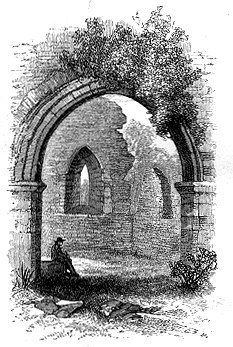|
|
On The Welsh Border.,
Page 2 of 14
Hence the prodigious strength and extent of the border castles, whose ruins now make the country picturesque, and which provoked from Dr. Johnson the remark that the court-yard of a castle in Wales is capable of containing all the castles in Scotland. Hence the extensive ruins of “huge Caerphilly”, of Raglan, of Chepstow, and of many others which dot the landscape at intervals so frequent as to tell an eloquent story. It is difficult to comprehend, in these days of equality before the law, the state of society which existed in mediaeval times, when all absolute monarchy was set up here in every little district, with a baronial castle for a centre; but one is amazingly helped toward such comprehension by roaming about from one ruin to another, and discovering that it is actually possible to visit several within the limits of a single day. It is the statement of a romantic historical fact to say that the border bristled with these feudal vultures’ nests; but it makes the matter practical to a degree that is positively sensational&mdash like a realistic stage effect &mdash to set out on a tramp over this storied land of the border barons, and find that your first five miles brings you to Caldecot Castle, your second to Chepstow Castle, your third to Tintern Abbey (eloquent of the same tale the castles tell, though in a different way), whence nine miles carry you to Monmouth, and seven more to Raglan, and that you have passed en route, and without pausing to look at them, the ruins of Penhow, Pencoed, Magor, Lianvair, Dinham, Striguil, St. Briavels, and nameless others. In the small border county of Monmouthshire, which is not so large as Oneida County in New York (a centre of the Welsh in America), there are no fewer than twenty-five ruined castles, besides many priories and abbeys, each with its tale of battles, sieges, fortunes, during the centuries that stretch between the Norman Conquest and the days of Oliver Cromwell. Of the least of these ruins many interesting pages may be written. Magor and Pencoed stand within two miles of each other. Any where else but in Wales each would be a tourist’s lion, which enthusiastic travellers would journey far to see.
From these numerous castles it was the pleasant wont of the Norman lords marchers to sally with their steel-clad warriors into the interior of Wales, and when they could catch the Welshmen — which was not always, for these wary people had an exasperating trick of fleeing into mountain fastnesses, and of hiding in marshy lands which the mounted knights dared not attempt to cross &mdash to use them in bloody, ferocious, and cruel sort. Old writers tell how the Normans tore the quivering flesh from their enemies with iron talons; how they burned them, chopped off their heads, cut their bodies into small pieces, and committed other atrocities which may not be described. In return for these attentions the Welsh made inroads into the border districts of England, where they burned towns and slew people, and whence they bore home into Wales loads of spoil. Throughout many generations an almost perpetual warfare was waged, and small was the mercy shown on either side in the hour of victory. But the Norman border barons, except when they sallied forth in armies accoutred for fighting, kept themselves pretty closely shut up within the walls they had erected; to quit them, save in force, was to be pounced upon by their watchful, restless, skillful, and ruthless foes. Their lives would have been but little worth the living, so dull and quiet must have been the routine thereof, had not they inclosed vast spaces of ground, with great halls and courts, kitchens, parlors, chapels, stables, out-houses and lawns, wherein to make merry with wine and wassail in the intervals between fights. Near Caldecot stand two interesting villages, one on either hand — Caerwent, a decayed Roman city, whose story is similar to that of Caerleon; and Portskewitt, where Harold before he was king had a palace, in which he entertained Edward the Confessor with great splendor. |
|
|
2
Books & articles appearing here are modified adaptations
from a private collection of vintage books & magazines. Reproduction of these pages is prohibited without written permission. © Laurel O'Donnell, 1996-2006.
|
||


